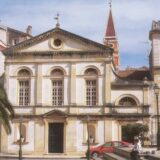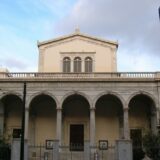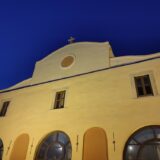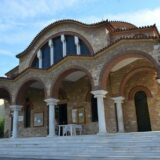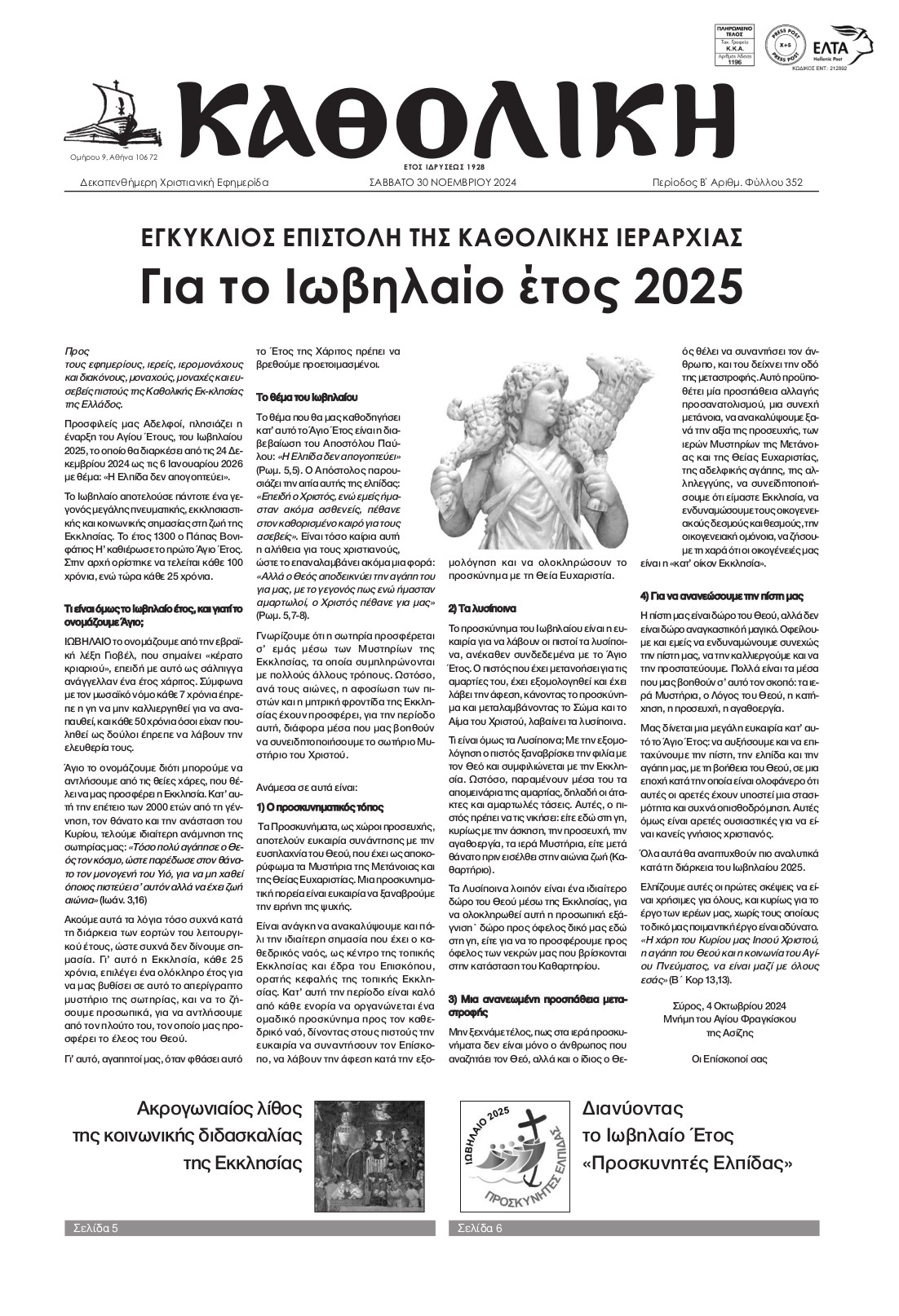Fr. Marcos Foskolos
Christian and Byzantian Museum
Speech for 06 October 2021
Under your protection… Sub tuum praesidium…
When the East and West unite to honour the Virgin Mary
for the Church’s benefit
The concept of “holy war”, offensive or defensive, is frequently mentioned in the Old Testament, whilst being completely omitted from the New Testament. The ancient Church, in fact, did not accept in its ranks, certain professions, such as the military. Murder was forbidden for Christians, even when if it were to be committed in defence. “Non-violence”, in imitation of Christ, who, according to the expression of Peter, “suffereth not and suffereth not”, was the new way of life proposed by Jesus for the new era for humanity (Lk 6,20 c). A first exception seems to have been made in the last century of the persecutions, when among the martyrs there were saints who served in the military and were respected by the majority of the Christians. Such Saints were Saint George, Saint Demetrius, Saint Eustatius, Saint Theodore and others. Those already in the military who sought Baptism were therefore allowed to remain as soldiers, but under special conditions, such as carrying only weapons used for defence.
The similarities that followed the actions between the Christian world and the empire, in practice, annulled the evangelical ideal of “non-violence” and the ancient Greek ideal of “for altars and hearths” seemed to be applied. And Christian sociology began to question the East and West about ‘holy war’, about the crusades and the ‘fair war’. Endless ink was spilt to defend or reject the theories in question. I think the first Christian holy war or crusade occurred in the East in the year when Emperor Heraclius declared war and invaded Persia to recover the Holy Cross the Persians had seized as an heirloom for their empress who was Christian but not Orthodox.
However, Christ’s Cross began to transform, from a spiritual weapon against invisible enemies into an offensive physical weapon against the irreligious and heretics in the East and the West.
In this story, a mixture of spiritual/political and military history, but also of various theological interpretations, the Virgin Mary, the mother of Jesus Christ, was involved. Because of her status as the Mother of Jesus to whom the Lord entrusted his disciple John while on the Cross, and by extension all his disciples throughout the ages (Christians, obviously, and the Orthodox in particular…). The interpretation of the episode in chap. 12 of Revelation, where the dragon lurks in order to devour the woman’s son, the woman who is girded with the sun, crowned with 12 stars and the moon (symbol of the powers of darkness) under her feet, she is also seen as the Mother of Jesus, symbol and icon of the Church. But the woman, mentioned in the book of revelation, does not fight against the dragon, but this task is assigned to the Archangel, Saint Michael, the great prince, leader of the heavenly battalions. The woman does not fight. She does not take up the sword or any other weapon. So she could be an intercessor (and a symbol) of defence and protection. As it was, for the Eastern and Western tradition. It applies more to womanhood and motherhood, since it is in a mother’s nature to protect her children from various enemies and dangers.
Extremely quickly these notions of “protection” were widely used in cult texts. We all know the well-known troparion that is included in the Paraclete Canon, Minor and Great.
But I would like to draw your attention to another case, more interesting from the point of view of the history of the text, which has parallel texts, one in the Greek East and one in the Latin West:
Byzantian Version Latin Version
Ὑπὸ τὴν σὴν εὐσπλαγχνίαν, Sub tuum praesidium,
καταφεύγομεν, Θεοτόκε. confúgimus sancta Dei Génetrix;
Τὰς ἡμῶν ἱκεσίας, nostras deprecatiónes ne despícias
μὴ παρίδῃς ἐν περιστάσει, in necessitátibus;
ἀλλ᾽ ἐκ κινδύνων sed a perículis cunctis
λύτρωσαι ἡμᾶς, líbera nos semper,
μόνη Ἁγνή, μόνη εὐλογημένη. Virgo gloriósa et benedícta.
This prayer was also spread to the relevant branches of the two main traditions (from Greek Byzantine to Byzantine Old Slavic) and from Roman Latin to Latin Ambrosian of Milan.
What a surprise it was, however, when in the first decades of the 20th century an even older rendition of it was discovered on a scroll, lost in the sands of the Egyptian desert, in the Coptic tradition, as a troparion in the Christmas Eve Service of the Coptic Church. It has even been documented that the original composition of this prayer was written in the context of a warlike atmosphere, namely during the persecution of Christians by the Roman emperors Decius and Valerian (249-251, 253-260 AD) which caused the death of a large number of martyrs in Egypt.
When the text was published in 1938, it was not difficult to allocate the Coptic text with the Byzantine troparion as well as with the Latin hymn, which was already known and widely used by both great ecclesiastical traditions and not only.
The Byzantine version is the most elaborated (linguistically and rhythmically) with a purpose, obviously, to its use not only in private prayer, but mainly in monastic services. Today it is used as the Theotokion at the end of the Vespers service.
In the West, where it was translated into Latin, this hymn acquired its Gregorian melody, still known today, as a theomimetic antiphon in the Hours and at the end of Night prayer during the Gregorian reform of worship.
But I want to underline one very important detail. In the Latin translation, the expression “under the mercy of God” is rendered as “Sub tuum praesidium”. The word praesidium is by no means a rendering of the concept of mercy or compassion. Praesidium is commonly used in military language and means “strong fortress” or “strong military reinforcement”.
There was, therefore, not a long way to go before we find the characterization of the Virgin Mary as “the super-martial general” in the well-known masterly stock of the Acathist Hymn. Tradition tells us that it was composed by St. Romanus the Melodist during the siege of Constantinople by the Avars (626 A.D.) while the Emperor Heraclius was on the famous military campaign, to which I have referred before to, against the Persians, the first Christian war or crusade.
Here we find the Virgin Mary in a devotional text being transformed from a defensive “fortress of protection” (cf. Ps 30 and 70) into a “champion general”, since she was considered to be the one who destroyed the enemy’s fleet by provoking a violent storm.
And from here, going forward for almost 1000 years, we arrive at the year 1571, when the event that our present assembly celebrates took place, the Battle of Lepanto. 450 years exactly, since it took place at the entrance of the Patraikos Gulf, near the South Echinades Islands, an episode of modern military history that is said to have marked modern European history.
In truly difficult and dangerous times, Pope Pius V sensed the danger of the Islamic fanaticism that had already enslaved all the Christians of North Africa and the Balkans, was already near the boarders of Vienna and Southern Italy. The Sultan’s next target was to attack Rome. With overwhelming efforts, Pope Pius V managed to unite into a naval force the fleets of Venice, Spain, Malta and the states of Italy, what were called the Sacra Lega (Sacred Coalition). Many Greeks also fought in the Christian fleet and they came from all the Greek territories that were under the Venetian rule. But the Pope, besides trusting in the united Christian fleet, had also placed his hopes in the Virgin Mary and asked the faithful to pray to stop the danger with penance, all holding the Rosary in hands. The Rosary is a necklace of roses portrayed as offerings to the Virgin Mary which she is content with, the Archangel’s greeting, the Hail Mary. To this he added dozens of titles, drawn by the piety of the Christians from Scripture and from their love, creating another garland to the Mother of God:
Virgin most prudent,
Virgin most venerable,
Virgin most renowned,
Virgin most powerful,
Virgin most merciful,
Virgin most faithful,
Mirror of justice,
Seat of wisdom,
Cause of our joy,
Spiritual vessel,
Vessel of honor,
Singular vessel of devotion,
Mystical rose,
Tower of David,
Tower of ivory,
House of gold,
Ark of the Covenant,
Gate of Heaven,
Morning star,
Health of the sick,
Refuge of sinners,
Comforter of the afflicted,
Help of Christians,
Queen of angels,
Queen of patriarchs,
Queen of prophets,
Queen of apostles,
Queen of martyrs,
Queen of confessors,
Queen of virgins,
Queen of all saints,
Queen conceived without Original Sin,
Queen assumed into Heaven,
Queen of the most holy Rosary,
Queen of peace,
Pope Pius asked the Christians who were in the safety of their homes to join and cooperate with the Christians who were fighting on the ships and in the galleys and to fight side by side. Members of many brotherhoods poured into the streets of the Eternal City and other cities to which the message had been heard in time to invoke the Woman of the Apocalypse, against whom the enemy of the faith was raging. It is said that the alliance of the thousands of civilian along with the fighters on the galleys was decisive, as millions of believers raised their voices to heaven on that day, 7 October 1571, crying out, “Ave, Maria! Hail, Mary!!!’’
The victory of the Christian fleet in the Greek waters was overwhelming and the results of the naval battle are still visible today. The following year, 1572, with the Bulla Christus Dominus, Pius V instituted the feast of Our Lady of Victory (feast of 7 October), while his successor, Pope Gregory XIII, with the Bulla Monet Apostolus, instituted the feast of the Rosary (1573) to be celebrated annually and by the whole Church on the first Sunday of October. There have been numerous initiatives by popes since then, up to Pope St. John Paul II, to promote the prayer of the Rosary. Remarkable types of icons were created, especially in connection with St. Dominic and St. Catherine of Siena, which promoted this prayer, and hundreds of thousands of Fraternities and organizations for its propagation. This effort was particularly fruitful for Tinos, where a special icon was made for the Virgin of the Rosary, which was placed in the Cathedral of the Castle and survives to this day, while the PtR was officially proclaimed patroness of the Ecclesiastical Province in 1725 and in 1860 her new Cathedral was dedicated to her.
I will not go into further details. I will leave you to enjoy them audiovisually in the halls of this wonderfully hospitable museum, the Christian and Byzantine Museum, where the worthy Mrs. Catherine Delaporta and her amazing team has not only gathered historical depictions of the naval battle, but also objects that were in the galleys of the time. I will stop here and I would like to remind you that spiritual weapons are more effective that material ones.
Fr. Markos Foskolos


